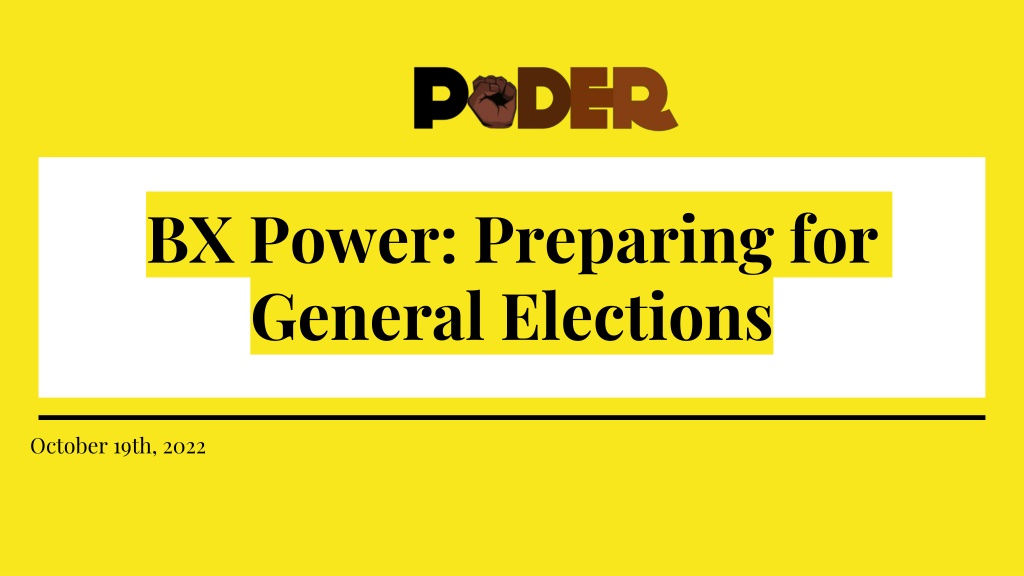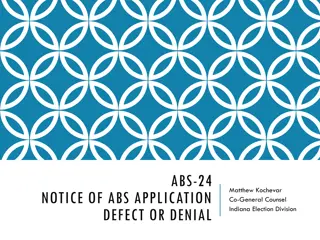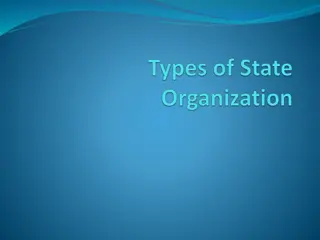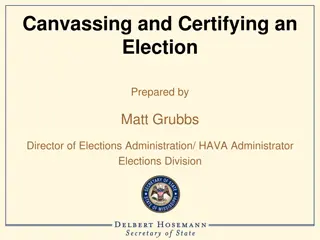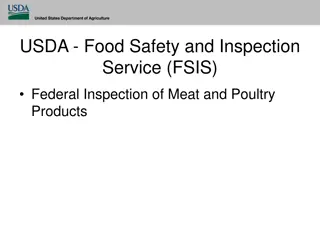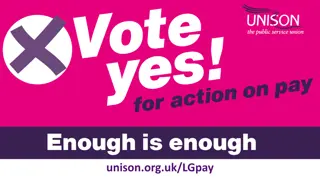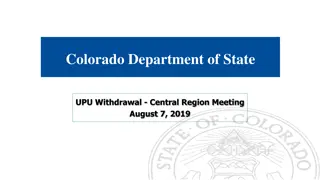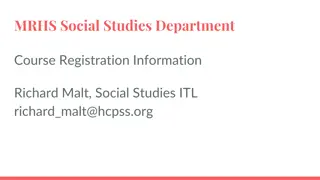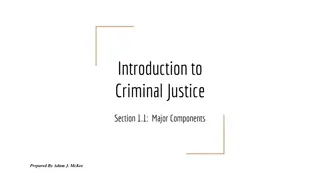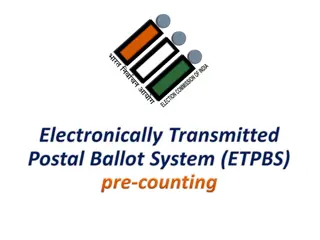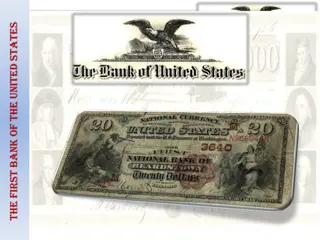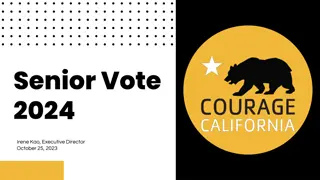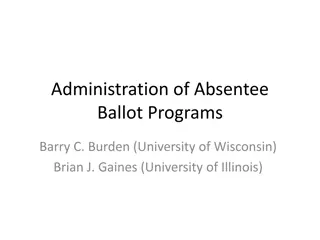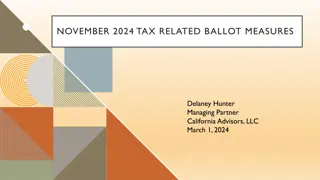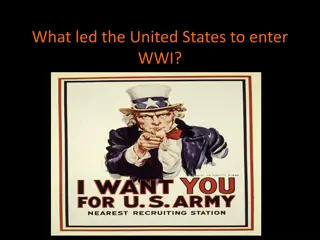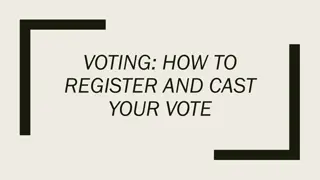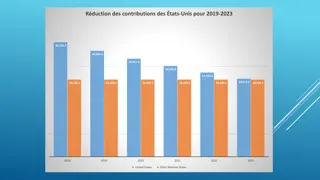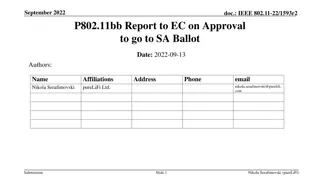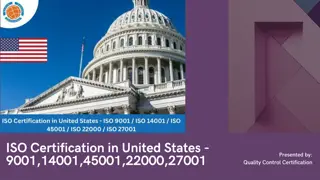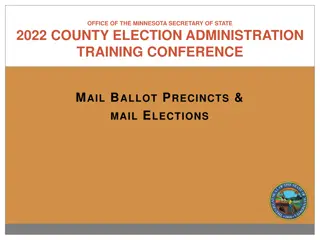Ballot Measures in the United States
In the United States, a ballot measure is a law, issue, or question that is put to voters on a statewide or local ballot for decision-making. These measures can be initiated by citizens, referred by government bodies, or automatically placed on the ballot. Examples include proposals related to environmental bonds, government values, racial equity, and cost of living. Through engagement and voter participation, communities can drive meaningful changes through the ballot box.
Download Presentation

Please find below an Image/Link to download the presentation.
The content on the website is provided AS IS for your information and personal use only. It may not be sold, licensed, or shared on other websites without obtaining consent from the author. Download presentation by click this link. If you encounter any issues during the download, it is possible that the publisher has removed the file from their server.
E N D
Presentation Transcript
BX Power: Preparing for General Elections October 19th, 2022
PODER is a Spanglish, nonpartisan organization that is building local power, block by block. PODER is a Spanglish, nonpartisan organization that is building local power, block by block. Through multigenerational and multicultural engagement, we are catalyzing the changes our Through multigenerational and multicultural engagement, we are catalyzing the changes our communities need for future generations. Changing the culture around political engagement communities need for future generations. Changing the culture around political engagement through Black and Brown community through Black and Brown community- -led organizing we use civic literacy, voter registration, and led organizing we use civic literacy, voter registration, and advocacy as a tool to build New York City. advocacy as a tool to build New York City. We are building local power by catalyzing the next generation of changemakers, block by block We are building local power by catalyzing the next generation of changemakers, block by block and see our power building to the polls (ballot box), by engaging local stakeholders in deep civic and see our power building to the polls (ballot box), by engaging local stakeholders in deep civic engagement and government accountability in order to transform out communities long term. engagement and government accountability in order to transform out communities long term. By 2042, we can close the race and age gaps in voter registration and move justice forward block by block.
- What is a ballot measure? - Review of Ballot Proposals for General Elections. - Making a Voting Plan Agenda
In the United States, a ballot measure measure is a law, issue, or question that appears on a statewide or local ballot for voters of the jurisdiction to decide. (a) (a) placed on the ballot through citizen (b) (b) referred to the ballot by the state legislature or local government body; or (c) (c) automatically placed on the ballot with no action from a legislature or governing body via a state law or constitutional provision requiring such a ballot measure. ballot What is a ballot measure? - Source: Ballotpedia
Ballot Proposal 1: Clean Water, Clean Air, and Green Jobs Environmental Bond Act of 2022 Ballot Proposal 2: Government Statement of Values Ballot Proposal 3: Racial Equity Office, Plan, and Commission Ballot Proposal 4: Measure the True Cost of Living in NYC What's on the Ballot? Source: NYC Votes
Ballot Proposal 1: Clean Water, Clean Air, and Green Jobs Environmental Bond Act of 2022 What you ll see on the ballot: What you ll see on the ballot: - To address and combat the impact of climate change and damage to the environment, the "Clean Water, Clean Air, and Green Jobs Environmental Bond Act of 2022 authorizes the sale of state bonds up to four billion two hundred million dollars to fund environmental protection, natural restoration, resiliency, and clean energy projects. Shall the Environmental Bond Act of 2022 be approved? - What this means: What this means: - This proposal would allow for state bonds to be sold to fund environmental projects. These projects are intended to mitigate flood damage, protect natural resources, conserve land and natural spaces, and improve water quality and infrastructure. -
Ballot Proposal 1: Clean Water, Clean Air, and Green Jobs Environmental Bond Act of 2022 The details: The details: - New York State could allocate $4,200,000,000 from creating state debt and selling state bonds to protect New York's natural resources and reduce the impact of climate change. - The state Comptroller would be authorized to issue and sell bonds up to $4,200,000,000. - Money would be allocated for specific purposes: - At least $1,100,000,000 for restoration and flood risk reduction. - At least $650,000,000 for open space land conservation and recreation. - Up to $1,500,000,000 for climate change mitigation. - At least $650,000,000 for water quality improvement and resilient infrastructure. -
Ballot Proposal 2: Government Statement of Values What you ll see on the ballot: What you ll see on the ballot: - This proposal would amend the New York City Charter to: Add a preamble, which would be an introductory statement of values and vision aspiring toward a just and equitable city for all New Yorkers; and Include in the preamble a statement that the City must strive to remedy past and continuing harms and to reconstruct, revise, and reimagine our foundations, structures, institutions, and laws to promote justice and equity for all New Yorkers. The preamble is intended to guide City government in fulfilling its duties. Shall this proposal be adopted? - - - - -
Ballot Proposal 2: Government Statement of Values What this means: What this means: - This proposal would add introductory text, known as a preamble, to the New York City Charter. This preamble would serve as a guiding principle for city government to promote justice and equity for all New Yorkers. - The details: The details: - The city charter would add a preamble since it does not currently have one. - The preamble would acknowledge historical injustices, embrace the city s diversity, recognize what residents need to thrive, and establish values grounded in equity and justice that shape our city. - The preamble would guide how the city government operates. -
Ballot Proposal 3: Racial Equity Office, Plan, & Commission - What you ll see on the ballot: What you ll see on the ballot: This proposal would amend the City Charter to: - Require citywide and agency-specific Racial Equity Plans every two years. The plans would include intended strategies and goals to improve racial equity and to reduce or eliminate racial disparities; - Establish an Office of Racial Equity and appoint a Chief Equity Officer to advance racial equity and coordinate the City s racial equity planning process. The Office would support City agencies in improving access to City services and programs for those people and communities who have been negatively affected by previous policies or actions, and collect and report data related to equity; and - Establish a Commission on Racial Equity, appointed by City elected officials. In making appointments to this Commission, elected officials would be required to consider appointees who are representative of or have experience advocating for a diverse range of communities. The Commission would identify and propose priorities to inform the racial equity planning process and review agency and citywide Racial Equity Plans. - Shall this proposal be adopted? - - What this means: What this means: - This proposal would create an Office of Racial Equity, require a citywide Racial Equity Plan every two years, and create a Commission on Racial Equity. New York City does not currently have a government agency focused on creating and promoting equity. This proposal establishes how the city government can advance equity, with a particular focus on racial equity.
Ballot Proposal 3: Racial Equity Office, Plan, & Commission The city would create an Office of Racial Equity, led by a Chief Equity Officer appointed by the Mayor. This office would: Develop a citywide Racial Equity Plan every two years based on Racial Equity Plans produced by each city agency. Support city agencies in measuring and collecting data on wellbeing across racial, ethnic, and other communities. Identify priority neighborhoods to be highlighted in Racial Equity Plans. Establish a Citywide Access Design program to increase access and reduce barriers to city programs, services, communications, and decision-making. Help city agencies address marginalization of individuals and communities. Codify the Taskforce on Racial Inclusion and Equity, which would provide policy advice to the Chief Equity Officer and coordinate governmental efforts to increase racial equity. Every two years the Mayor would create a citywide Racial Equity Plan and city agencies would create their own Racial Equity Plans. These plans would inform the city s budget planning. The city would create a Commission on Racial Equity with 15 members appointed by the Mayor and City Council Speaker. The Commission would: Propose community priorities to inform the racial equity planning process. Review citywide Racial Equity Plans. Track agency compliance with racial equity planning. Receive public complaints about city agencies that are creating racial disparities.
Ballot Ballot Proposal 4: Measure the True Cost of Living in NYC - What you ll see on the ballot: What you ll see on the ballot: - This proposal would amend the City Charter to: - Require the City to create a true cost of living measure to track the actual cost in New York City of meeting essential needs, including housing, food, childcare, transportation, and other necessary costs, and without considering public, private, or informal assistance, in order to inform programmatic and policy decisions; and - Require the City government to report annually on the true cost of living measure. - Shall this proposal be adopted? - What this means: What this means: - This proposal would require the city to measure the actual cost of living for city residents to meet essential needs. This measurement is intended to focus on dignity rather than poverty. - The details: The details: - Beginning in 2024, the city would be required to track the actual cost of living for housing, childcare, child and dependent expenses, food, transportation, healthcare, clothing, and more. - Findings would be reported alongside metrics used to measure poverty or set eligibility for public benefits.
Your plan for who voting for. Your plan for what voting for. Your plan on when going to vote. Your plan on where going to vote. Your plan on how going to vote. who you are what you are What is a voting plan? when you are where you are how you are
Do research on the positions and candidates that are going to be on your ballot: Visit: nycvotes.org Use your address to search What s on the ballot? Candidates running for: U.S. Senate U.S. House Governor Lieutenant Governor Attorney General Comptroller State Senate State Assembly NYS Supreme Court Judges Civil Court Judges Surrogate Court Judges. WHO are you voting for?
Do research on the proposals that will show up on your ballot: For New Yorkers Visit: nycvotes.org Use your address to search What s on the ballot? Review the ballot initiatives we discussed today. WHAT are you voting for?
Are you going to vote in person or by mail? If you plan on voting by mail, you must request an absentee ballot. Visit nycabsentee.com OR call 866-868-3692 Deadline to request an absentee ballot: October 24 October 24th Only request an absentee ballot if you plan to vote by mail. If you decide to vote in person after requesting an absentee ballot, you will have to submit an affidavit ballot. HOW are you going to vote? th
Are you voting early or on election day? Early Voting takes place from Saturday Oct. 29 Saturday Oct. 29th 6 6th No early voting on Monday Nov. 7th Election Day is Tuesday Nov. 8 Election Day is Tuesday Nov. 8th Visit findmypollsite.vote.nyc Verify where your poll site is. It may be different from your election day poll site. Check the hours the polls are open. Whenever you decide to vote, plan what time of day you plan to vote and what you need to make sure your do vote. th Sunday Nov. Sunday Nov. th WHEN and WHERE are you going to vote? th
Research! Have conversations with loved ones and people you are close to. Make a plan! Involve others in your plan. Show up to Vote! And encourage others to do the same! If they can! If you are unable to vote, get involved. Volunteer for a candidate you like Encourage your community to be involved. NEXT STEPS
THANK YOU Visit us @ www.poder.nyc Follow us @poder.nyc
